
[Publisher’s note: This article is by BikePortland’s In-Depth reporter Libby Tucker. Tucker is a freelance journalist whose stories have been published by the Associated Press, MSNBC.com, The Oregonian, and others. She was most recently a staff writer for the Daily Journal of Commerce where she covered transportation, construction and energy. She is also the author of the blog, Naked Energy and is a regular contributor to the NYTimes.com blog, Green Inc. This will be a two-part story (read Part Two here).]
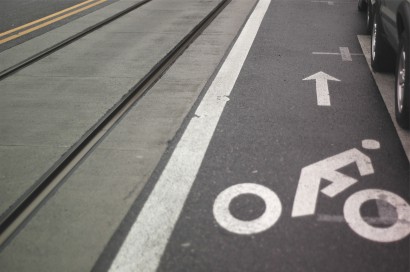
(Photos © J. Maus)
Where Bikes and Streetcar Collide
The eastside loop offers a lesson in Portland’s ever-evolving multi-modal Planning
A “Bikes and Transit” survey, conducted by Alta Planning and Design in October, revealed that more than 67 percent of 1,520 cyclists responding said they had crashed on streetcar or light rail tracks.
Riding home from her job in Northwest Portland last September, Catherine Halpin was thrown from her bike as she crossed NW 23rd Avenue where the streetcar tracks curve onto Lovejoy.
“I usually keep a heads up for the track,” said Halpin. “I don’t know if I just wasn’t paying attention or if it was my back tire.”
Halpin landed in the middle of the intersection on her elbow, which jammed the humerus bone upwards and broke her shoulder. She’s nearly healed and back on the bike but says she’ll never see the streetcar tracks the same way again.
“I’m pro public transportation, but I wince every time I see the yellow caution sign with a picture of the little person going over their handlebars,” said Halpin, a Northeast Portland resident. Even with the posted signs, she said, “I don’t think I realized what a hazard they were.”
Portland’s transportation planners, however, know full well the problem streetcar tracks pose to cyclists. As biking to work has gained popularity in Portland, growing from 2.7 percent of commuters in 1990 when the city initiated streetcar planning to 8 percent in 2008, according to the Portland Bureau of Transportation, so too have the number of bicyclists reporting tangles with the tracks.
A “Bikes and Transit” survey, conducted by Alta Planning and Design in October, revealed that more than 67 percent of 1,520 cyclists responding said they had crashed on streetcar or light rail tracks.
“We’re improving the design with each one we do… hopefully we’ll continue to seriously upgrade the design because it’s not good enough yet. It’s not even close.”
— Rick Gustafson, executive director of Portland Streetcar, Inc.
Portland still has no adopted guidelines or policies for streetcar design related to bicycles, but with each successive project, streetcar planners and designers have experimented with different solutions. The new eastside streetcar loop, for example – which is now in the final design stages and slated to open in 2011 – includes improvements such as a designated bike boulevard, a cycle track, bike signals and bike boxes to enhance safety and improve flow near the streetcar tracks along portions of the alignment.
But the city still has a long way to go to get back on track with other bike-forward cities, said Mia Birk, whose firm Alta Planning and Design consulted on the eastside loop project. Thorough bike planning only happened in one of four sections along the 3.3-mile extension, which will stretch from Northwest 10th Avenue and Lovejoy in the Pearl District over the Broadway Bridge to Northeast 7th Avenue, and then south through the Lloyd District to the Oregon Museum of Science and Industry along Martin Luther King Jr. Boulevard and Grand Avenue.
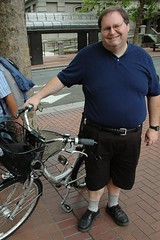
Portland Streetcar’s citizen
advisory committee. He’s working
hard to make sure bikes and
streetcars play nicely together.
The Pearl District will offer a fully integrated neighborhood design for bike facilities, while more moderate planning happened in a section of Northeast 7th Avenue, and tracks along the entire inner central eastside south of Interstate-84 won’t contain any additional bike facilities at all.
“We’re improving the design with each one we do and trying to find creative ways to deal with bike and streetcar conflicts,” said Rick Gustafson, executive director of Portland Streetcar Inc. “And hopefully we’ll continue to seriously upgrade the design because it’s not good enough yet. It’s not even close.”
The design team’s approach on the eastside loop was to identify four main areas of conflict for streetcar and bike interaction, said Gustafson, starting with the Pearl District, a designated “bike district” under the bike master plan now in development. The project marks the first time the city has hired an independent consultant to specifically help plan the interaction between bikes and the streetcar.
“The original alignment was relatively insensitive to bikes,” said Chris Smith, a member of the bicycle master plan committee and chairman of the Portland Streetcar’s citizen advisory committee. “We were just so focused on getting streetcar done that we didn’t bother with the details.”
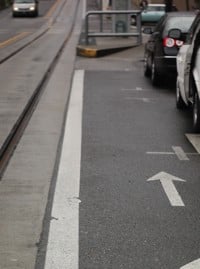
On NW Lovejoy, notice how the streetcar platform comes into the bike lane…
|
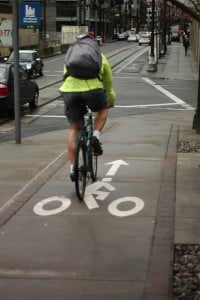
forcing riders up into the pedestrian area.
|
The classic problem along the Pearl District’s existing streetcar alignment is the streetcar platforms, which were stuck smack in the middle of the bike lane. The early solution was to reroute bikes onto the sidewalk behind the platform (ie Northwest 13th Avenue and Lovejoy), but that just created “chaos,” said Birk. It was a “valiant effort to find a solution,” she said. But, “we didn’t design it very well.”


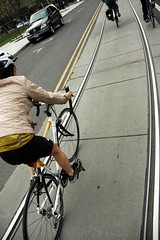
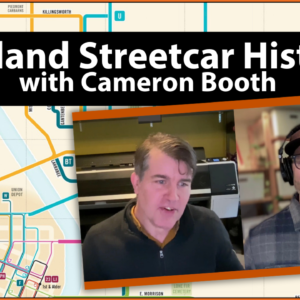

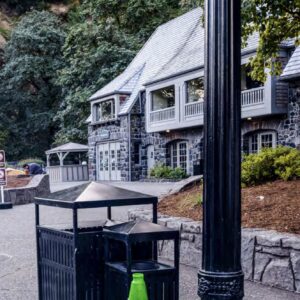

Thanks for reading.
BikePortland has served this community with independent community journalism since 2005. We rely on subscriptions from readers like you to survive. Your financial support is vital in keeping this valuable resource alive and well.
Please subscribe today to strengthen and expand our work.
Okay, since it is already jump on Jonathan day (Happy birthday. 🙂 This is why I don’t tell people when it is my birthday.) I dislike multipart articles. One big one is better.
ya, rail tracks are a mistake most new riders make….once. think of it as a right of passage…
I would think in the eyes of most urban transporation budget analysts….since bikes don’t produce any real income for the city, bike lanes aren’t treated as priority when new rail lines are built…
and I agree with matthew d….split stories are tough to follow.
sorry you guys don’t prefer the two-part style of this. i’ll keep that in mind for next time. the second part will be up tomorrow AM.
I’m in agreement with the earlier posts about multiple part stories, fwiw.
Wow, I just ate it on my bike for the first time at this intersection of Lovejoy and NW 23rd. I ride around a lot and go over my share of tracks be it tram or Max on nice days to snowy days. I completely ate it when the tracks curl around to 23rd avenue because it’s hard to get a good angle on those tracks when they curve. It was also when there was about an inch of wet snow on the ground which had a lot to do with it. Luckily I’m young and healthy but it hurt like hell. There’s got to be a better design. If you want proof, watch the bridge pedal when they get off the Fremont Bridge into Northwest. i would say 1 out of 10 eat it on the tracks even with someone standing there warning them.
The lesson learned is that even seasoned riders may crash when taking routes where tracks exist.
It’s frustrating that two modes that are typically complimentary are in conflict. This feels like infighting but the issue is real. I hope the analysis comes up with effective solutions that hit safety, functionality and cost targets.
Why not have bicycle lanes on one street and the streecar on another? There ya go, problems solved…I’m partly kidding, by the way.
The streetcar and max tracks definitely make riding difficult in some areas and, as with many others, I have some scars/stories of my own concerning them. Another irritant is on the east side in particular–the old tracks that have been mostly paved over, but raise out of the pavement. I’ve had some real ugly times on those.
This is precisely why the city should build trolley buses/trackless trolleys instead of streetcars. They’re a lot quieter, a lot cheaper, and still convey the sense of “permanence” that developers are looking for. Streetcars are a solution in search of a problem, or as far as cyclists are concerned, just a problem.
All the streetcar rails are hazards to cyclists. Buses on electric lines like Seattle have are far more friendly to cyclists and pedestrians alike. This city just likes them because they look Euro, but they are very expensive! You could put bike lanes, cyclepaths, bike paths, etc., all over the city for the price of one streetcar line. They don’t work any better than electric buses as mass transit but are a real safety hazard to cyclists.
San Fransisco converted several of their electric bus lines [back*] to streetcars recently, and the ridership basically doubled overnight. So it looks like a lot of people do think that streetcars are “better” than electric buses, specifically the thousands of new people that rode on them…
*They were built as streetcars in the 1920s, they converted to electric buses in 1950s.
While the tires on my city bike are fat enough to not fall into the tracks, that’s only part of the problem. When those metal rails are wet they are just as dangerous. I really avoid roads with tracks at almost all costs, and I live right on the streetcar tracks.
Yep. I almost hit the deck rolling into the rail slots. It just made me much more aware, kinda like rolling on the expressway or billeted on board a submarine.
Get complacent. Get DEAD.
I’ve got to agree in a way with placing the tracks on MLK and Grand. Two of the worst roads to ride on; better than running the tracks down a nice quiet street! And perhaps a good way to lure some people friendly businesses back to what’s basically a freeway bypass right now.
Tracks are one of my push-topics when I meet cyclists just venturing out into the streets. “You know about railroad tracks, right?”
“This city just likes them because they look Euro…”
We should look toward Europe for examples of bikes & rail living in harmony. There are many, many examples of cities with high bike ridership and lots of street-running rail. What you’ll find is that our design is not that out of the ordinary.
DE #15, I have been to Europe, Paris, Madrid, Barcelona etc., do not have street running rail. Europe does have a lot of rail going between cities which is a great thing and we should do the same. They do not have a lot of street cars in their cities!
Hahahaha, looks like you just named all the cities in Europe. Here’s Amsterdam, and there are many others: http://www.flickr.com/photos/65782378@N00/2651991869/
Krakow… http://www.flickr.com/photos/krakowbicycles/3232105174/
Even better Krakow: http://www.flickr.com/photos/question_everything/3022158149/
Prague: http://www.flickr.com/photos/petererikforsberg/2886589751/
Zurich: http://www.flickr.com/photos/carfreeworldview/3038172695/
Jonathan, you should do a post on how other cities handle street-running rail/bikes. Looking just at Portland allows myopic views like old&slow to pervade [the idea that we’re the only idiots trying this unnatural dance]. We just need some diversity of context.
old&slow #16 – amsterdam and freiburg (germany) – two of the most awesome cycling cities ive been lucky to spend significant time in – both have significant on-street light rail, as do many many other euro cities.
Have you been to Europe? You showed a couple of examples but this is not common in most cities. Most cities in Europe don’t have any room in the central city for rail at all. The streets are narrow, old , have a lot of charm and they would never tear them up for a rail system. I am not dissing Europe, their rail systems are light years ahead of us. I am just saying that for the most most part, street rails are not common in most european cities.
OMG, yes, I have been to Europe. it’s only a couple examples as I only spent 5 min on flickr.
Even Paris DOES have street running rail. I’m not accusing you of not having been there… The T3 line runs in its own lane, but crosses streets and cyclists and autos have to cross the rails. Other french cities with street running rail include:
Marseille:http://www.flickr.com/photos/carlitos/1986670571/
Strasbourg: http://www.flickr.com/photos/66833619@N00/344130898/
Grenoble: http://www.flickr.com/photos/simonov/214154175/
Also Nantes.
Outside of France, Geneva Switzerland: http://www.flickr.com/photos/cherylandrich/240541165/
Helsinki: http://www.flickr.com/photos/claudio_ar/2512728650/
Common is not the point, I’m just saying it is done well in several other places that we could learn from, including Europe.
old&slow #21:
see, now youre qualifying it with “central city”.
and he showed examples from 4 cities with on-street light rail. i added a 5th to his 4. you gave examples of 3 cities without it.
ive been to europe, spent time in many major cities throughout much of it, and id say on-street, in-town light rail is common enough to not discount wholesale. there are some absolutely stellar examples of it.
oh, and by the way, barcelona does have tram/streetcar/light rail lines. and so does paris.
Many of them are in the center city. Most European cities have several wide boulevards suitable for multi-modal adaptation. In addition to the cities mentioned, there is also Marseilles, Strasbourg, Grenoble, Nantes, Geneva, Helsinki and PARIS. I may even be leaving some out.
I give up. I really want rails running on every street in this town. It will make my life riding bicycles so much more pleasant. Dodging cars is not enough of a challenge, I need rails in all the streets so I can dodge cars and rails at the same time. All this so people who are too lazy to walk, ride, take a bus, etc. can get to where they want to go in style!
There was a Marketplace story on an Amsterdam bike mechanic (listen at
http://marketplace.publicradio.org/display/web/2008/07/04/bike_mechanic/
what was one of the most common things he fixes? That’s right, bikes damaged by crashing on street car tracks. Just our luck, we get all the bad things from Amsterdam with few of the good.
Joel, this is my last post on this. Why the big defense of a transportation system that costs millions of dollars for not much benefit? We could be spending our money on so many other ways to get around in our city. Buses, bicycle lanes and bicycle paths, walking malls, etc., are so much cheaper and better for our society that expansive “nice looking” systems that don’t move people around any better! The cost of the street car system in this city could have paved hundreds of miles of bicycle trails that could benefit a lot more of us at a lot less cost than more hazardous rails in the streets!
So… what is wrong with having bike lanes on parallel streets next to the streetcar lines? Riding in dense trafficked areas like the Pearl is challenging enough without worrying about catching a wheel when avoiding a darting pedestrian or impatient driver. The Lovejoy section is a bit scary… Perhaps I have a heightened fear of breaking things – not young anymore. I know there’s traffic flow issues, through streets and whatnot, but good bike routes should be safe.
old&slow #25
For the cost per person moved, you are right, it isn’t as good as bicycling or walking, but light rail is actually cheaper to run per passenger mile than buses. (And the places you cite for not having surface rail have subway systems instead, which are often Billions of dollars to build.)
I’m not arguing that there aren’t problems with streetcar tracks, there certainly are and we should work on that. However…
Matthew, I wasn’t going to post again but I couldn’t resist. Light rail is different than street cars. Moving people from Gresham to Portland is different than moving people from NW23rd to Burnside. You can walk faster! The cost of moving people a few blocks downtown on rail vs. electric buses is far more expensive. I just think that people can get around our small city much cheaper than an expensive rail system that I think is a nightmare for cyclists.
So let me get this straight, old&slow. it’s ok to have some streets that are dedicated primarily to bikes (like bike boulevards), but it’s not ok to have some streets that are dedicated primarily to rail transit?
There are many many cities in Europe that use streetcars/trams other than the ones that people have listed above, including Budapest, Vienna, Brussels, Helsinki, Stuttgart, Munich, Berlin, Oslo, and that’s just the beginning. Oh yeah, and since it matters so much to you, I have been to Europe. But I guess since you named the 3 cities you’ve been to, you’d know better (even though 2 of them do have operational SURFACE streetcar lines).
By the way, it’s absurd to argue that the logical conclusion of the newest streetcar line expansion will result in rails on every street. Everyone here loves biking, but it’s not the only viable means of transportation. Personally, I’d rather put up with having to cross a streetcar line or two if it means less cars on the road – I know I’m never going to get right hooked by a streetcar.
old&slow:
I spent a month in Germany during the World Cup and got to see quite a few cities in Germany and other parts of Europe, many of the cities I went to had functioning, modern streetcar systems (though they’re called “trams” over there…S-Bahn in German).
To add to the earlier list:
Frankfurt (my home base during the World Cup, the streetcar runs right outside of the main train station… i.e. central city):
http://upload.wikimedia.org/wikipedia/commons/5/50/Altstadtstrecke_Stra%C3%9Fenbahn%2C_Frankfurt.jpg
Berlin:
http://www.lilano.de/catalog/images/Tram-Bernauer-Strasse_200605DSC2054.JPG
Rome:
http://www.railway-technology.com/projects/rome/images/rome4.jpg
Paris (yes, Paris, France):
http://tramfacts.files.wordpress.com/2007/06/paris-narrow.jpg
Brussels:
http://upload.wikimedia.org/wikipedia/commons/8/87/Brussels_Tram.jpg
Strassburg:
http://www.geschichteinchronologie.ch/velotouren/2003-2/14-Strassburg-tram-neben-velo.jpg
I’ve ridden the street trams in Frankfurt, Berlin, Rome, Prague, Amsterdam, and Strassburg, some even in the central city!
Regardless of what you think about them as a cost-efficient mode of travel, you’re 100% wrong about cities in Europe having streetcars. They may not all run through the old portions of town (though you can see above that one of them runs right next to the Colosseum in Rome), but they most definitely are all over the place… and in many places that people bike.
Falling in the track is one problem. Slipping on the track is another, and can cause you to fall in the track. You can definitely make modifications to make the tracks less slippery:
1) make the top of the rail level with the surrounding concrete. It’s about 1/4″ above the pavement now. This means you hit the rail as you ride over it (impact can make you lose traction), and you spend more time in contact only with the rail than you would if it was flush with the pavement.
2) bolt saw-blade strips of steel to the inside and outside of the rail, sticking up as high as the top of the rail. Make the teeth about 1/2″ apart, with flat tops to the teeth, and spaced at 1″ intervals. And the saw-blade about 1/2″ wide.
This will provide lateral adhesion, so when you ride over the tracks your wheels will be less likely to slip out from under you.
Thoughts? Need a diagram?
Ted
Personally I think there should be a real wide bike rim with no tire so you can ride on the rails and you can “share the tracks” with light rail
Jim, you sound like you’re ready for a genuine RAILBIKE! I’m sure TriMet & the streetcar folks won’t mind your using their tracks.
http://rrbike.freeservers.com/
Toronto (where I live) has an extensive streetcar system, running through the parts of town that have the most bicycle use, including most of the the major East/West streets that go downtown (King, Queen, College/Carleton, and Dundas Streets).
There are no concessions made for cyclists. In my opinion, it’s the most dangerous aspect of cycling in Toronto.
Another commenter pointed out:
“The lesson learned is that even seasoned riders may crash when taking routes where tracks exist.”
I can attest to this; I took a huge ass-over-teakettle spill as a result of getting caught in the track in ’07, and I would consider myself a seasoned rider. I was on a street where I knew there are tracks; but my attention for the crucial second was on cars, not the tracks.
A close friend dumped this past summer too. I suggested to him that all Toronto bike commuters would eventually lose a fight with a track (to really learn the lesson to be aware of the tracks at all times). He pointed out to me this was his second time – his “first” was 20 years ago. He figured when he came due for his 3rd time (in 20 years), he’ll likely break a bone (he is 40 now, and will be 60 then).
My wife, also got some road rash last summer after getting a wheel caught in a track. This was her first time, and I hope the last; it almost put her off riding to work.
I have no good suggestions for how to improve the situation; the city is committed to the streetcars (they are in the process of ordering a new fleet of cars which should last for another 20+ years), and have recently replaced quite a bit of old track. They are even planning on expanding the network, although in areas where cars will a separate Right of Way.
Matthew Denton:
“San Fransisco converted several of their electric bus lines [back*] to streetcars recently, and the ridership basically doubled overnight.”
Not to be antagonistic, but can you provide a reference for that? I was not aware that they had completed any conversions.
Look at the trolleybuses SF has in operation: they are relics. If they had invested in modern, low floor, air conditioned, etc. trolley buses, like Vancouver and Philadelphia have done recently, they would remain a cheaper, safer alternative to streetcars.
Sure, the bus line 8-Market, (now known as the train F-Market,) converted in 1995.
There was no American streetcar manufacturer that could provide the cars, so while you’d have a point if they’d invested in modern, low floor, air conditioned streetcars, they didn’t. Instead, they rounded up high floor ones build before WWII from around the world, (many of them had actually been sitting in museums,) fixed them up, and put them back into service. Given that, you’re next question will be is this a “tourist railroad” or a transit operation? The schedule says transit operation: It runs every 6 minutes at rush hour on weekdays, with less trains midday/evenings or on Saturday and Sundays…
What do you guys think about people riding between the rails? I cringe when I see people doing that and I’ve heard it mentioned on this site from commenters that that is what you should do. I can think of so many ways that this is a bad idea. Thoughts?
Why don’t they move the bike coridor over a block or 2 so its not on the same street with the tracks?
I used to ride up Northrup between the rails all the time…smooth new concrete and not many cars. You just have to be very careful when you “exit.”
Despite the haggling over who is more familiar with European rail systems (I thought I was on PortlandTransport for second there), I think this is turning into an interesting thread.
To Jim, and others with similar comments: While it seems like a reasonable ‘option’ to place a bike corridor on a separate street from the streetcar, would you consider that ‘ideal’? If you look at most major commercial and mixed use corridors in this city (Hawthorne, Burnside, Belmont, Division, Powell, Alberta, Mississippi, Fremont, etc) they have few if any bike-friendly treatments, aside from parking. But this is where we want to go isn’t it — To get our groceries, rent a movie, go to breakfast, drink at the pub? I think we need facilities that lead directly to these destinations because that’s what a truly bike-friendly city looks like. Well, the Streetcar wants to take people to all those same destinations, so that means we need a design and a plan that allows access to both types of riders, but doesn’t put cyclists at risk of serious injury.
I think it’s encouraging that progress is being made with each new segment of the streetcar system. However, I think improvements to the existing system are equally, if not more, important. Saying that the new lines will be better does nothing to decrease the number of broken bones and ER visits being caused by our current network.
I think the importance of this concern can be summed up with a quote from another commenter:
“My wife, also got some road rash last summer after getting a wheel caught in a track. This was her first time, and I hope the last; it almost put her off riding to work.”
Worse than deterring potential new riders, risks like these threaten to remove existing cyclists from our roadways.
All the on-street rail in Portland is responsible for a minimum of two trips to the Emergency Room by cyclists daily, and these numbers will no doubt continue to grow as more rail is laid….
This should be completely unacceptable to cyclists, as should the commandeering of popular bike routes for new rail lines by the streetcar ‘planners’.
I had a similar experience of going over the handlebars after getting into a streetcar track. My back wheel was ruined though all I ended up with was some bruising. Is there a place where I could report that so it becomes an addition to these statistics?
Thanks
Hear, hear, Ian S. (#42):
“I think we need facilities that lead directly to these destinations…”
One thing we (I) want to avoid is too much segregation. restricting bikes to certain routes, either by signage (law/ordinance), or by making some streets too dangerous, is a bad precedent. Essentially it puts a sign on every business that says, “Drivers and transit users welcome–cyclists please enter through back alley”. No, thanks.
I have this fear that separation is a double-edged sword. On one hand it says, “Here are some safe places for cyclists to ride”, but on the other, it says, “here are the only places cyclists can ride”.
^^This is exactly why mandatory bike path and bike lane use laws are discriminatory! Public streets are for public use, regardless of whether you are on foot, on a bike or in a motor vehicle.
^ Nope, try again. You can be cited for jaywalking if you don’t directly cross the street. Walking IN the street carries a fine.
^#47 just another example of how our public space has been coopted for motor vehicles. Thanks for supporting my point!
According to one historian, the earliest known use of the word jaywalker in print was in the Chicago Tribune in 1909.[2] (The earliest citation in the Oxford English Dictionary is from 1917.) The term’s dissemination was due in part to a deliberate effort by promoters of automobiles, such as local auto clubs and dealers, to redefine streets as places where pedestrians do not belong.[3]
http://en.wikipedia.org/wiki/Jaywalking
http://www.cars-suck.org/littera-scripta/jaywalkers.html
“…Walking IN the street carries a fine.”
Yes, but does driving a car past (or to) the front door of your final destination carry a fine? Does riding transit past (or being let off transit at) the front door of your final destination carry a fine? Does walking past (or to) the front door of your final destination (on the sidewalk) carry a fine?
Making some streets off limits to bikes may or may not be discriminatory from a street access point of view, but what if I am no longer allowed to approach my final destination using my transportation mode of choice? Sure, cyclists are hardy individualist-types that don’t mind the extra physical exertion of parking a block away and walking, or dismounting and walking a bike a block or two, but the principle of making it illegal for users of a particular mode to conveniently approach a destination–when users of other modes have full and convenient access–smacks of discrimination.